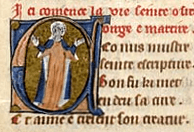Osgyth
| Osgyth | |
|---|---|
|
An illuminated capital commencing the anonymous "La Vie seinte Osith, virge e martire" (Campsey Manuscript, British Library Additional Ms 70513, fol. 134v) | |
| Born | Quarrendon, Buckinghamshire |
| Died | 700 AD |
| Venerated in |
Anglican Communion Roman Catholic Church |
| Feast | 7 October |
| Attributes | Depicted carrying her own head |
| Controversy | Popularly considered a saint in England, but possibly not formally canonized |
| Osgyth | |
|---|---|
| Queen consort of Essex | |
| Born | Quarrendon, Buckinghamshire, Mercia |
| Died | 700 |
| Spouse | Sighere of Essex |
| Issue | Son |
| Father | Frithuwold of Surrey |
| Mother | Wilburga |
| Religion | Christianity |
Osgyth (or Osyth) (died 700 AD[1]) was an English saint. She is primarily commemorated in the village of Saint Osyth, Essex, near Colchester. Alternative spellings of her name include Sythe, Othith and Ositha.
Life
Born in Quarrendon, Buckinghamshire (at that time part of Mercia), she was the daughter of Frithwald, a sub-king of Mercia in Surrey, and was the niece of St Edith of Aylesbury and Saint Edburga of Bicester. Her mother was Wilburga, the daughter of the pagan King Penda of Mercia.
Raised in a convent in Warwickshire under the direction of Saint Modwen her ambition was to become an abbess, but she was too important as a dynastic pawn to be set aside.
Forced by her father into a dynastic marriage with Sighere, King of Essex, she did her dynastic duty and produced him a son. While her husband ran off to hunt down a beautiful white stag, Osgyth persuaded two local bishops to accept her vows as a nun. Then, eventually, perhaps after Sighere's death, she established a convent at Chich, in Essex, where she ruled as first abbess.
Her death was accounted a martyrdom by some, but Bede makes no mention of Saint Osgyth. The 13th-century chronicler Matthew Paris repeats some of the legend that had accrued around her name. The site of her martyrdom became transferred to the holy spring at Quarrendon. The holy spring at Quarrendon, mentioned in the time of Osgyth's aunts, now became associated with her legend, in which Osgyth stood up after her execution, picking up her head like Saint Denis in Paris, and other cephalophoric martyrs and walking with it in her hands, to the door of a local convent, before collapsing there. Some modern authors link the legends of cephalophores miraculously walking with their heads in their hands[2] to the Celtic cult of heads.

Veneration
Later, the manor of Chich (now St Osyth) in Essex was assumed as part of his royal demesne by the Danish King Canute, who granted it to Earl Godwin, and by him it was given to Christ Church, Canterbury. At the Conquest it was transferred to the Bishopric of London.
On the site of a former nunnery at Chich, Richard de Belmeis of London, in the reign of Henry I founded a priory for canons of Saint Augustine, and dedicated it to Saint Osgyth; his remains were buried in the chancel of the church in 1127: he bequeathed the church and tithes to the canons, who elected as their first abbot or prior William de Corbeil, afterwards Archbishop of Canterbury (died in 1136).
His benefactions, and charters and privileges granted by Henry II, made the Canons wealthy: at the Dissolution of the monasteries in 1536, its revenues were valued at £758 5s. 8d. yearly. In 1397 the abbot of St Osgyth was granted the right to wear a mitre and give the solemn benediction, and, more singularly, the right to ordain priests, conferred by Pope Boniface IX.[3] The gatehouse (illustrated), the so-called 'Abbot's Tower' and some ranges of buildings remain.
Osgyth's burial site at St. Mary the Virgin, Aylesbury became a site of great, though unauthorized pilgrimage; following a papal decree in 1500, the bones were removed from the church and buried in secret. The Catholic Encyclopedia (1913) gives Saint Osgyth no mention. Undeterred, according to the curious 17th-century antiquary John Aubrey (author of the Brief Lives), "in those days, when they went to bed they did rake up the fire, and make a X on the ashes, and pray to God and Saint Sythe[4] to deliver them from fire, and from water, and from all misadventure." A house in Aylesbury is still called St Osyth's in her honour.
Her feast day is 7 October. She is normally depicted carrying her own head.
References
- ↑ "Orthodox England," http://www.orthodoxengland.org.uk/saintso.htm, Accessed 7 October 2010
- ↑ Note: "The stories of St. Edmund, St. Kenelm, St. Osgyth, and St. Sidwell in England, St. Denis in France, St. Melor and St. Winifred in Celtic territory, preserve the pattern and strengthen the link between legend and folklore," Beatrice White observes. (White 1972:123). White, Beatrice, "A Persistent Paradox" Folklore 83.2 (Summer 1972), pp. 122-131, at p. 123.
- ↑ Egerton Beck, "Two Bulls of Boniface IX for the Abbot of St. Osyth" The English Historical Review 26.101 (January 1911:124-127).
- ↑ That is, Saint Osgyth.
Further reading
- Oxford Dictionary of National Biography
- Biographical Dictionary of Dark Age Britain.
- Geoffrey of Burton's life of Modwenna includes material on Osgyth.
- Bethell's "Lives of St. Osyth of Essex and St. Osyth of Aylesbury", Analecta Bollandiana 88 (1970).
- Bailey, "Osyth, Frithuwold and Aylesbury" in Records of Buckinghamshire 31 (1989)
- Hohler, "St Osyth and Aylesbury", Records of Buckinghamshire 18.1 (1966).
External links
- Osgyth 2 at Prosopography of Anglo-Saxon England
- St. Osyth, Essex: Official Site: "About St. Osyth" has some historical detail
- Picturesque England: St. Osyth's priory, with details of her legend (text)
- Britannia.com "Lives"
- St Osyth's Spring Animated and Narrated Edition of the St Osyth Story
- Alban Butler, Lives of the Saints. St Osyth, martyr
